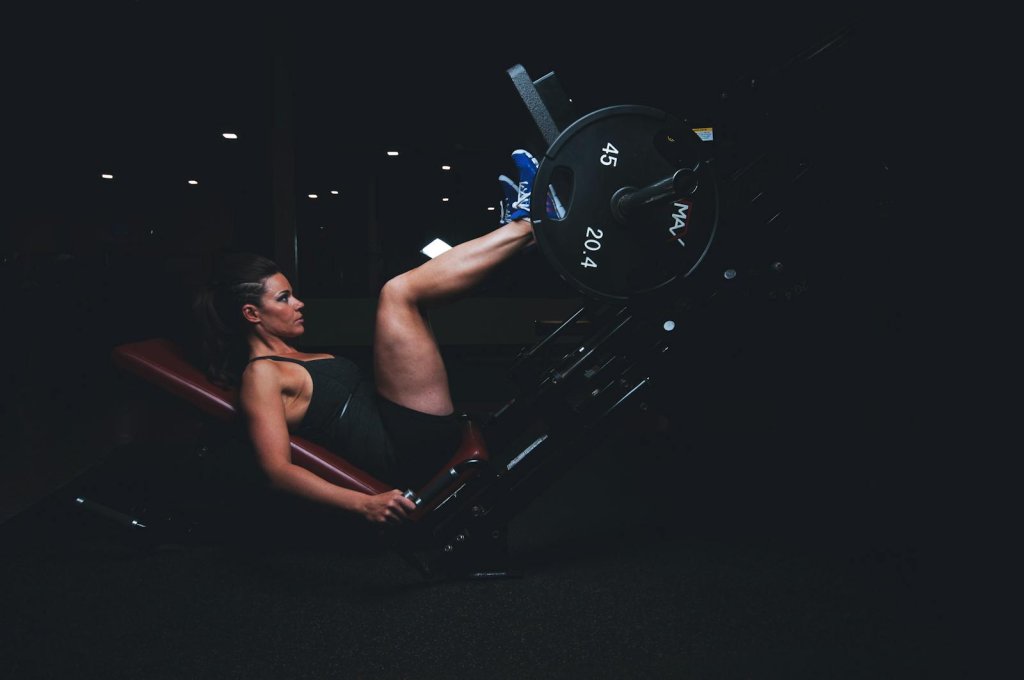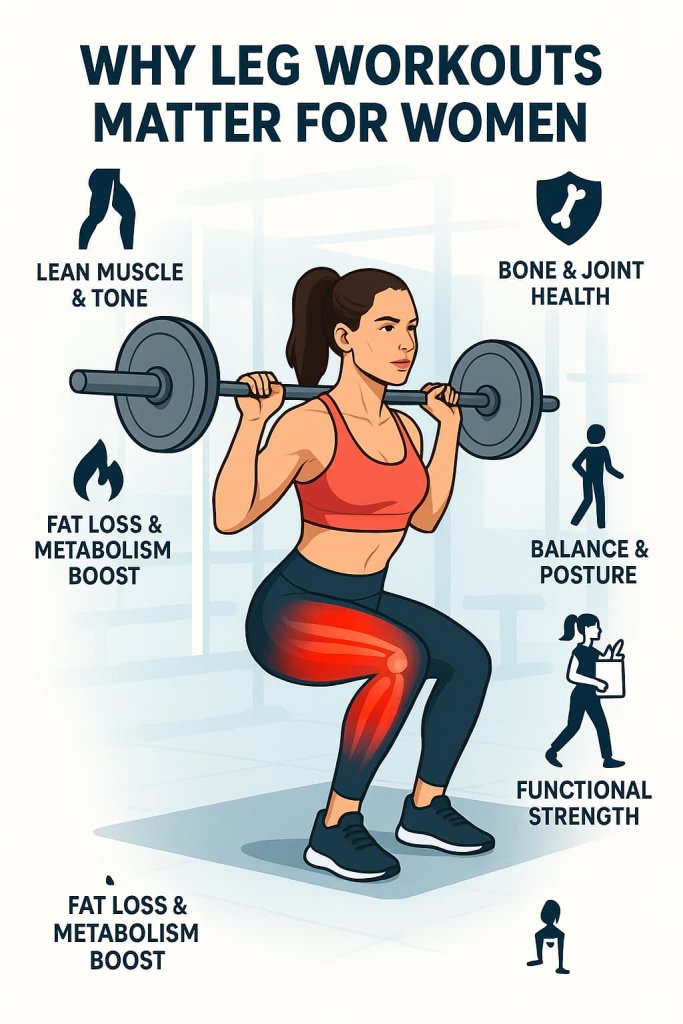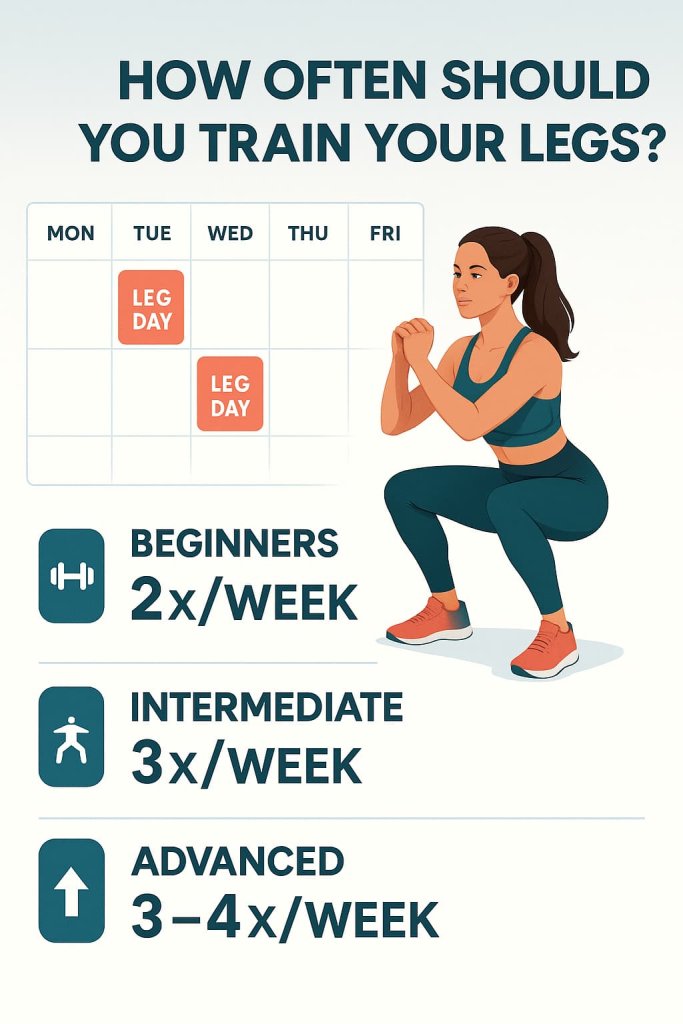The best leg workouts for women combine compound and isolation moves that target the quads, hamstrings, and glutes — helping you build strength, tone your lower body, and boost overall confidence. Whether your goal is power, endurance, or aesthetics, a well-structured leg routine delivers visible and lasting results.

Strong legs are essential for balance, posture, metabolism, and everyday mobility — all critical to long-term health. Below are 15 of the most effective, research-backed leg exercises, each with clear step‑by‑step instructions, expert training tips, and answers to frequently asked questions.
Why Leg Workouts Matter for Women
Leg workouts aren’t just for athletes — they’re essential for every woman. Multiple studies show that consistent lower-body resistance training in women improves strength and lean mass, enhances walking speed/functional mobility, and supports flexibility and joint function.

Key benefits include:
- Increases lean muscle and tones thighs and glutes
- Boosts metabolism and supports fat loss
- Improves bone density and joint stability
- Enhances posture, balance, and overall athletic ability
- Builds strength that translates to everyday life
Fact: According to Experts, women who include lower-body resistance training 2–3 times weekly improve strength and flexibility while reducing injury risk.
How Often Should You Train Your Legs?

For optimal results:
- Beginners: 2× per week (full-body or lower-body focus)
- Intermediate: 3× per week split (quads, hamstrings, glutes)
- Advanced: 3–4× per week with progressive overload
Rest at least 48 hours between intense sessions for muscle recovery and growth.
The 15 Best Leg Workouts for Women
Each exercise below follows the same evidence-based format for clarity and effectiveness.
1. Barbell Back Squat
Why it works:
The barbell back squat is a powerhouse move that strengthens the entire lower body. It engages multiple large muscle groups at once, making it one of the best exercises for building strength, muscle mass, and calorie burn.
Muscles worked:
Quads, glutes, hamstrings, core.
How to do it:
- Position the barbell across your upper traps, just below the neck.
- Stand with feet shoulder-width apart, toes slightly turned out.
- Brace your core and lower your hips until your thighs are parallel to the floor.
- Drive through your heels to return to the starting position.
Trainer Tip:
Push your knees slightly out as you descend to protect your joints and keep your chest upright to avoid leaning forward.
2. Front Squat
Why it works:
This squat variation shifts the load to the front of your body, targeting the quads and demanding greater core stability and posture control.
Muscles worked:
Quads, glutes, abs, upper back.
How to do it:
- Hold a barbell across your front shoulders with elbows high and upper arms parallel to the floor.
- Keep chest lifted and core braced.
- Lower into a squat until thighs reach parallel.
- Drive upward through your heels to stand tall.
Trainer Tip:
Keep elbows pointing straight ahead throughout the movement to maintain balance and prevent the bar from rolling forward.
3. Bulgarian Split Squat
Why it works:
This single-leg exercise isolates each side to correct imbalances while sculpting glutes and quads. It also enhances stability and balance.
Muscles worked:
Glutes, quads, hamstrings, core.
How to do it:
- Stand a few feet in front of a bench and place one foot behind you.
- Lower your front knee until your thigh is parallel to the ground.
- Push through your front heel to return to standing.
Trainer Tip:
Maintain a slight forward lean from the hips, but keep your chest open — avoid rounding your back.
4. Romanian Deadlift
Why it works:
This movement builds posterior-chain strength, improving posture and athletic power while emphasizing hamstring and glute development.
Muscles worked:
Hamstrings, glutes, lower back.
How to do it:
- Hold a barbell or dumbbells in front of your thighs.
- With a soft bend in your knees, hinge your hips backward.
- Lower the weights until you feel a stretch in your hamstrings.
- Squeeze glutes and return to standing by driving hips forward.
Trainer Tip:
Keep your spine neutral and avoid excessive lowering — the goal is controlled tension, not range.
5. Walking Lunges
Why it works:
Walking lunges improve balance, coordination, and functional leg strength, all while toning your thighs and glutes.
Muscles worked:
Quads, glutes, hamstrings, calves.
How to do it:
- Step forward with your right leg and lower into a lunge until both knees are at 90°.
- Push off the back leg and step forward into the next lunge.
- Continue alternating legs for distance or reps.
Trainer Tip:
Take longer steps to activate the glutes more; shorter steps emphasize quads.
6. Step-Ups
Why it works:
Step-ups train each leg independently, improving coordination, balance, and lower-body strength while mimicking daily movements like climbing stairs.
Muscles worked:
Quads, glutes, hamstrings.
How to do it:
- Step onto a sturdy bench or box with one foot.
- Drive through the heel to lift your body up.
- Lower with control and repeat with the opposite leg.
Trainer Tip:
Don’t push off the trailing leg — keep tension on the working leg to maximize strength gains.
7. Sumo Deadlift
Why it works:
The wider stance targets inner thighs and glutes while putting less strain on the lower back than conventional deadlifts.
Muscles worked:
Glutes, hamstrings, adductors, core.
How to do it:
- Stand with feet wider than shoulder-width and toes turned slightly outward.
- Grip the barbell between your legs.
- Drive through your heels and extend hips to lift the bar.
Trainer Tip:
Keep your chest up and shoulders pulled back throughout the movement for safe lifting mechanics.
8. Leg Press
Why it works:
A controlled, machine-based exercise that builds powerful quads and glutes while allowing heavier loads safely.
Muscles worked:
Quads, glutes, hamstrings.
How to do it:
- Sit in the leg press machine and place feet shoulder-width on the platform.
- Lower the platform until knees are at 90°.
- Push upward without locking your knees.
Trainer Tip:
Vary foot placement — high targets glutes, low emphasizes quads.
9. Hip Thrust
Why it works:
One of the best isolation moves for glute strength, shaping, and hypertrophy. It also improves sprint speed and hip power.
Muscles worked:
Glutes, hamstrings, core.
How to do it:
- Sit on the floor with your upper back against a bench.
- Roll a barbell over your hips and bend your knees.
- Drive hips upward until your torso is parallel to the floor.
- Squeeze glutes at the top, then lower slowly.
Trainer Tip:
Tuck your chin slightly and pause at the top for 1–2 seconds for better muscle activation.
10. Goblet Squat
Why it works:
A perfect squat variation for beginners, helping to master form while strengthening quads and glutes.
Muscles worked:
Quads, glutes, hamstrings, core.
How to do it:
- Hold a dumbbell vertically at chest level.
- Lower into a squat until elbows touch knees.
- Push through heels to stand.
Trainer Tip:
Keep your chest proud and spine neutral — avoid letting the weight pull you forward.
11. Curtsy Lunge
Why it works:
This move tones the glutes and inner thighs while improving coordination and hip stability.
Muscles worked:
Glutes, quads, adductors.
How to do it:
- Step your right foot diagonally behind your left leg.
- Lower until your front thigh is parallel to the floor.
- Push through your front heel to return to start.
Trainer Tip:
Engage your core and move slowly to avoid twisting your knees inward.
12. Cable Kickback
Why it works:
A glute isolation exercise that enhances shape and activation, ideal as a finisher after compound lifts.
Muscles worked:
Glutes, hamstrings.
How to do it:
- Attach an ankle strap to a low pulley.
- Stand tall, holding the machine for support.
- Extend one leg backward and slightly upward.
- Return slowly under control.
Trainer Tip:
Don’t use momentum — pause briefly at the top of each rep for full contraction.
13. Lying Leg Curl
Why it works:
An isolation movement that strengthens hamstrings and supports knee joint stability.
Muscles worked:
Hamstrings, glutes.
How to do it:
- Lie face down on the machine and position ankles under the pad.
- Curl your legs toward your glutes.
- Lower slowly to starting position.
Trainer Tip:
Control the negative (lowering) phase — it’s where most muscle growth occurs.
14. Lateral Band Walk
Why it works:
Activates and strengthens smaller glute muscles that stabilize hips and improve overall balance.
Muscles worked:
Glute medius, glute minimus.
How to do it:
- Place a resistance band above your knees or around your ankles.
- Bend knees slightly and step sideways one leg at a time.
- Maintain tension in the band throughout.
Trainer Tip:
Keep toes pointing forward — don’t let the band snap your feet together.
15. Wall Sit
Why it works:
An isometric hold that builds lower-body endurance and tones quads without equipment.
Muscles worked:
Quads, glutes, calves, core.
How to do it:
- Lean back against a wall, knees bent at 90°.
- Hold the position for 30–60 seconds or longer as strength improves.
Trainer Tip:
Keep your back flat and heels grounded — avoid pushing with your hands or resting them on your thighs.
Common Mistakes to Avoid
- Neglecting form: Focus on controlled movements, not speed.
- Skipping recovery: Muscles grow during rest — schedule 1–2 days off.
- Using too little weight: Progressively overload to continue improving.
- Ignoring mobility: Stretch hamstrings, quads, and hips post-workout.
Sample Weekly Leg Workout Plan
| Day | Focus | Example Exercises |
|---|---|---|
| Monday | Strength | Barbell Squat, RDL, Hip Thrust |
| Wednesday | Unilateral | Bulgarian Split Squat, Step-Ups, Curtsy Lunge |
| Friday | Conditioning | Goblet Squat, Lateral Band Walk, Wall Sit |
Recovery and Stretching After Leg Day
Recovery builds strength. Post-workout stretching and rest reduce soreness and aid muscle repair.
Do this after every session:
- 5–10 minutes static stretching (quads, hamstrings, glutes)
- Foam rolling for soreness
- Light movement or yoga the next day
- Stay hydrated and eat protein within 30–60 minutes
Trainer Tip:
Never skip recovery — muscles grow and heal when you rest.
Frequently Asked Questions
1. How many leg days should women have per week?
2–3 sessions per week is ideal for most women, with at least 48 hours of rest between sessions.
2. Will leg workouts make my thighs bulky?
No. Strength training tones and defines muscles without adding bulk unless paired with heavy calorie surplus.
3. What’s the best exercise for glute growth?
Hip thrusts and Bulgarian split squats are top-rated for glute activation.
4. Can I do leg workouts at home?
Yes — use bodyweight variations like squats, lunges, and wall sits, or resistance bands for added challenge.
5. How long until I see results?
Visible toning and strength gains often appear within 4–6 weeks of consistent training and proper nutrition.
6. Should I train quads and hamstrings on separate days?
Advanced lifters may split sessions; beginners can train both in the same workout.
7. What’s the best way to warm up for leg day?
Do 5 minutes of light cardio, followed by dynamic stretches like leg swings and bodyweight squats.
Conclusion
Stronger legs are the foundation of a stronger you.
By focusing on progressive overload, balanced training, and proper recovery, you’ll not only sculpt your lower body but also gain strength, mobility, and lasting confidence.
Start small, stay consistent, and remember — leg day isn’t just about aesthetics; it’s about empowering your body for life.
